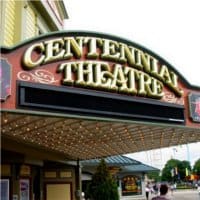Ortwein Sign, founded by M.H. Ortwein in 1923, boasts a century-long legacy in the sign industry. What’s less commonly known is that the company’s history intertwines with Hollywood itself. In its early years, M.H. Ortwein, who led the local union of sign painters, was instrumental in supporting sign painters who created promotional artwork for films by hand. These artisans were responsible for shaping the visual identity of movie marketing, ensuring that signage played a key role in how films were advertised and perceived.

With the Oscars around the corner, and our own cinematic history, we thought it would be the perfect time to explore the fascinating ways signage intersects with cinema. We’ve already covered the history of the iconic Hollywood Sign, but there’s so much more to the role of signage in the world of film including several incredible signs as seen on the big screen.
Iconic Signs in Film
Signs have not only been used to promote films but have also become integral elements within them. Some of the most memorable moments in cinema history feature signs that enhance storytelling, establish atmosphere, and even serve as key plot devices.
Citizen Kane (1941) – The Neon of El Rancho
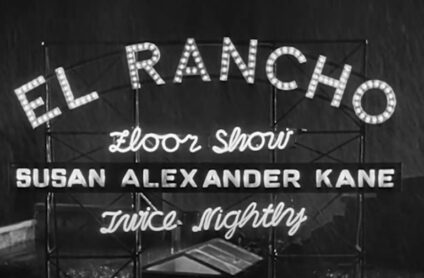
One of the earliest and most striking uses of signage in film appears in Citizen Kane. The shot of the El Rancho neon sign, where the camera seemingly moves through the glowing letters before transitioning into a rainy interior scene, was groundbreaking at the time. Orson Welles’ affinity for signage didn’t stop there—the movie opens with the camera pushing through a “No Trespassing” sign at Xanadu, setting the stage for the mystery surrounding Charles Foster Kane. Welles’ innovative cinematography made signs more than just background elements; they became storytelling tools.
Watch the iconic scene here: https://youtu.be/T1wP9R4uFoo
Casablanca (1942) – Rick’s Café Américain
Few signs evoke old-school glamour quite like the neon glow of Rick’s Café Américain in Casablanca. Unlike Citizen Kane, where signage was used for dramatic effect, here the sign serves a subtler role. The illuminated entrance of Rick’s café sets the scene for romance, intrigue, and wartime drama. Today, bars, clubs, and speakeasies across the world attempt to capture this nostalgic neon aesthetic, a testament to the timeless appeal of classic signage.
When Harry Met Sally (1989) – Katz’s Delicatessen
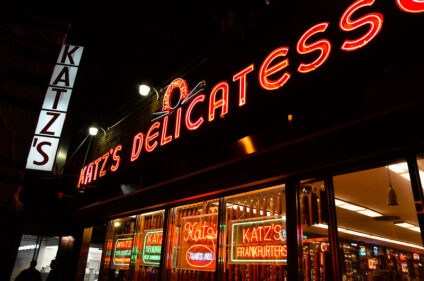
New York City has provided the backdrop for countless films, and its signs are just as famous. One of the most recognizable is the Katz’s Delicatessen blade sign, prominently featured in When Harry Met Sally. While Katz’s had been an NYC institution long before the film, its appearance in the movie cemented its status as a must-visit landmark. Fans still flock to the deli not only for its legendary pastrami sandwiches but also to snap photos under its iconic sign.
Breakfast at Tiffany’s (1961) – Tiffany & Co.
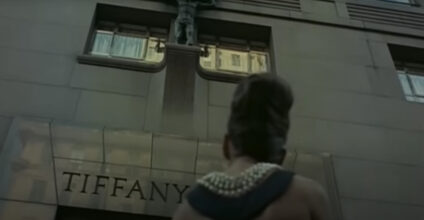
Another quintessential NYC sign graces the opening scene of Breakfast at Tiffany’s, where Audrey Hepburn’s Holly Golightly gazes wistfully into the window of Tiffany & Co. on Fifth Avenue. While many Tiffany locations exist worldwide, the sign outside this particular store remains an enduring symbol of elegance and sophistication, guiding fans to the very spot where cinematic history was made.
Die Hard (1988) – Nakatomi Plaza’s Signage
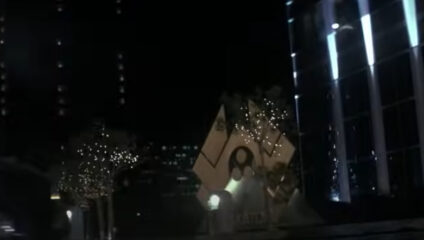
Unlike the neon and marquee signs seen in previous films, Die Hard gives us an entire wayfinding system. Nakatomi Plaza, though a fictional company, felt real in large part due to the detailed signage placed throughout the building. From monument signs to office directories, these elements added authenticity to the setting. While fans can visit the real-life Fox Plaza in Los Angeles, the signs themselves exist only in the film—making them a nostalgic sight every holiday season (or whenever you choose to rewatch Die Hard).
Signs That Leave a Lasting Impact
Whether they’re neon marquees, hand-painted facades, or fictional corporate logos, signs in film serve as more than just set dressing. They help define a movie’s world, evoke nostalgia, and, in some cases, become as iconic as the films themselves.
At Ortwein Sign, we celebrate the artistry of signage, past and present. Whether it’s creating a vintage-inspired neon sign or modern wayfinding systems, we know that great signs make a lasting impression—on screen and in real life.

